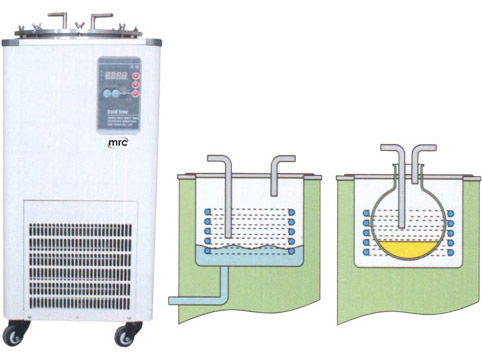MRC Cold Trap for Vacuum Pump in a variety of types
We recommend cold traps to protect your pumps from condensable vapors.
Cold Trap is used to capture water vapor & harmful gases emission from vacuum drying oven and pressure reduced concentration device, improving efficiency of the vacuum system, extending life-span of the vacuum pump.

How to choose-Cold Traps
A cold trap is a device that condenses vapors into solid or liquid, so they don't escape, leaving out permanent gases.
What Purpose Does Cold Traps Serve:
The cold trap primarily collects harmful vapors in the laboratory during laboratory evaporation to prevent them from getting into a vacuum pump.
It is also necessary to trap solvent vapors when working with a vacuum pump that uses oil. This is to prevent the vapors from getting into the oil in the vacuum pump. Then, corrosive or water vapors will damage the vacuum pump if they reach the vacuum pump oil. If this happens, it will damage the vacuum pump so much that it will be irreparable.
When dealing with non-vacuum pumps, trapping the vapors before you start the vacuum pump will ensure that the evaporation system is a closed system. This prevents vapors from escaping into the environment through the vacuum pump.
How Does Cold Trap Work?
The cold trap is the coldest part of the evaporation system during the process of evaporation.The purpose of the cold trap is to collect harmful fumes before they enter the vacuum pump.And to prevent an oil vacuum pump from being collected in the oil. Vapors are typically drawn to the coldest spots; they then get frozen and trapped in the condenser. This makes it possible for cold traps to fasten evaporation as vapors are trapped in a frozen solids state. This means the vapors are not condensed in the vacuum tubing, which naturally slows down the evaporation process.
What To Consider For Selecting The Ideal Cold Traps For Your Samples
Cold traps come in three different temperature levels, namely -50°C, -85°C, -105°C.
You can boost the moisture trapping efficiency if you select the correct Cold Trap temperature. You must select a cold trap that can reach a higher temperature than the freezing point of your samples.
For example, if you are working on an application with a solvent of -96.7°C freezing, such as methylene chloride, a -50°C cold trap will trap only -43.3°C of the solvent. On the Other hand, a -105°C will trap 87.7% of the volume we had initially.
In water samples, the -50°C cold trap will collect as much as the cold trap of -105°C.
Generally, when working with a sample with a mixture of solutions, the cold trap temperature should match the lowest freezing point in the mixture.
Abiding by these general rules or guidelines will give you the ideal trapping efficiency, ensuring that vapours don't get into the pump and the environment.

Uses of Cold Traps
1. Protection of Vacuum Pumps
Prevent contamination: Cold traps capture condensable vapors, such as water, solvents, or acids, that could otherwise enter and damage vacuum pumps.
Extend pump life: By preventing corrosive or reactive substances from reaching the pump, cold traps help maintain its efficiency and longevity.
2. Cryogenic Applications
Gas collection: Cold traps are used to freeze and collect specific gases for analysis or recycling.
Improving vacuum: They help achieve ultra-high vacuum by removing residual vapors from the system.
3. Distillation Processes
Solvent recovery: Cold traps condense and recover solvents during vacuum distillation or rotary evaporation.
Prevent contamination: They prevent volatile substances from escaping into the environment or contaminating other parts of the apparatus.
4. Sample Preservation
Cryopreservation: Cold traps are used in processes that require freezing biological or chemical samples to preserve their integrity.
Moisture removal: They are used to remove water vapor during freeze-drying.
5. Analytical Chemistry
Mass spectrometry: Cold traps protect the delicate instrumentation by capturing unwanted vapors.
Gas chromatography: They assist in trapping moisture or contaminants that could interfere with the analytical results.
6. Industrial Processes
Chemical manufacturing: Cold traps are used to condense or separate specific compounds during chemical synthesis or reactions.
Semiconductor industry: They are critical in maintaining clean and dry environments in semiconductor fabrication.
7. Environmental Applications
Air sampling: Cold traps capture pollutants or volatile organic compounds (VOCs) for environmental monitoring.
Waste treatment: They prevent the release of harmful vapors during waste disposal or recycling processes.
8. Freeze-Drying (Lyophilization)
Food and pharmaceuticals: Cold traps help in removing moisture from materials during freeze-drying, which is critical for preserving products.
9. Research and Development
Cryogenic experiments: Used in scientific research involving extremely low temperatures.
Material science: Cold traps are used in studies of materials that require controlled cooling environments.